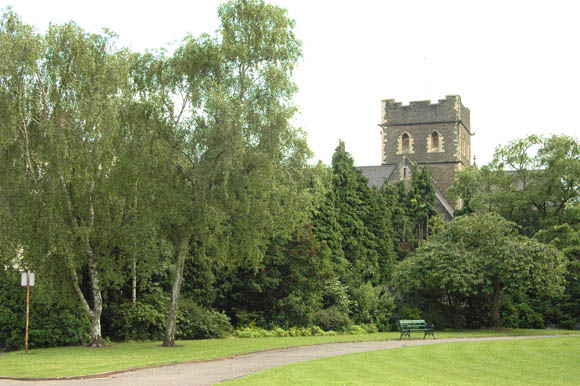Roath (Rh�th) - From 'A Topographical Dictionary of Wales' (1849)
ROATH (RH�TH), a parish, in the union of Cardiff, hundred of Kibbor, county of Glamorgan, South Wales, 1� mile (N. E. by E.) from Cardiff; containing 298 inhabitants. Rh�th, the original name of this place, is a common Welsh designation for ancient earthworks, of which there are several in the immediate vicinity: the late Mr. Edward Williams, the Glamorganshire antiquary, supposed the name to be derived from the station Ratostabius, which he fixes at Cardiff. The parish is situated on the western bank of the river Romney, over which is a bridge of one arch, and on the great western road through the county: the river is also crossed in this vicinity by a wooden bridge, 230 feet in length, along which passes the South Wales railway. The surface, forming an extent of about 1500 acres, is nearly a perfect flat, except that to the north of the village there is a gentle rise. Formerly the Romney, which here separates the counties of Glamorgan and Monmouth, inundated the moors to a great extent; but an embankment has been constructed, which has confined it to its proper channel. The quality of the soil is various, the upper lands towards the north being a red stiff clay, and the flat ground being composed of sandy loam and gravel, which, towards the moors, become covered with tenacious clay, fit for making bricks. The parish contains several good gentlemen's houses, of which Pl�s Newydd, in the castellated style, is the principal; and is divided into three lordships, Tewkesbury, Dogfield, and Keynsham, the manorial rights of the two first of which belong to the Stuart family, Marquesses of Bute, and those of the last to Sir Charles Morgan, Bart.
The living is a vicarage not in charge, endowed with �800 royal bounty; net income, �106: the tithes have been commuted for �307. 10., of which a sum of �160 is payable to the Dean and Chapter of Gloucester, �72. 10. to the Stuart family, also patrons of the benefice, and �75 to the vicar, who has twelve acres of land in the parish of Bedwas, and ten in that of St. Woollos, Monmouthshire. The church, dedicated to St. Margaret, is a small neat structure, with a chancel that was rebuilt by the first Marquess of Bute, who also erected, on the northern side of it, a splendid mausoleum for his family, where he and the Marchioness, and Lord Mountstuart, were interred. A day and Sunday school is supported chiefly by C. C. Williams, Esq. Near the centre of the rising ground to the north of the village is a spring of pure water, called Penylan Well, which has been inclosed, and is greatly resorted to by all classes on Easter Monday, when it is supposed that charms are wrought, fortunes foretold, and wishes registered at the mystic stream. |






